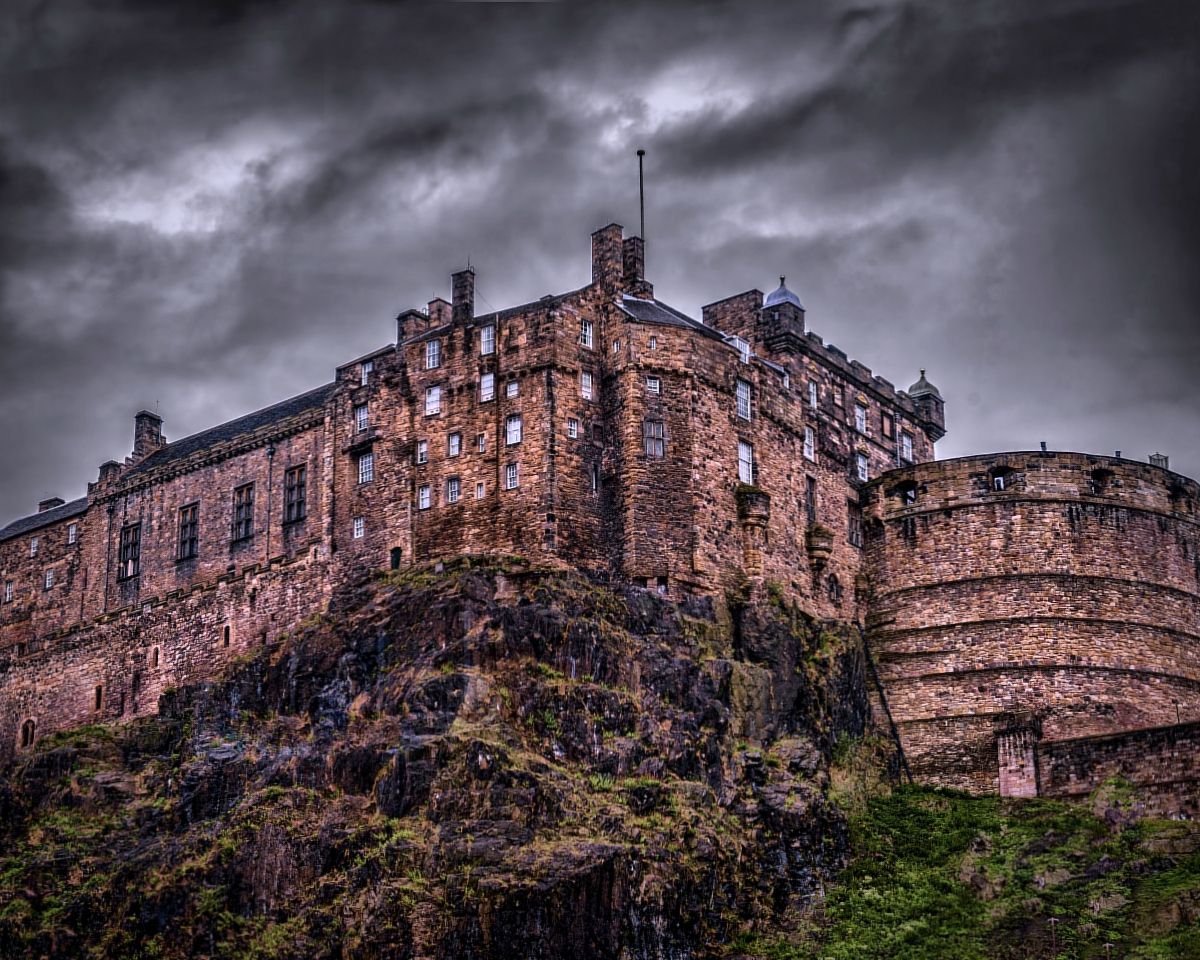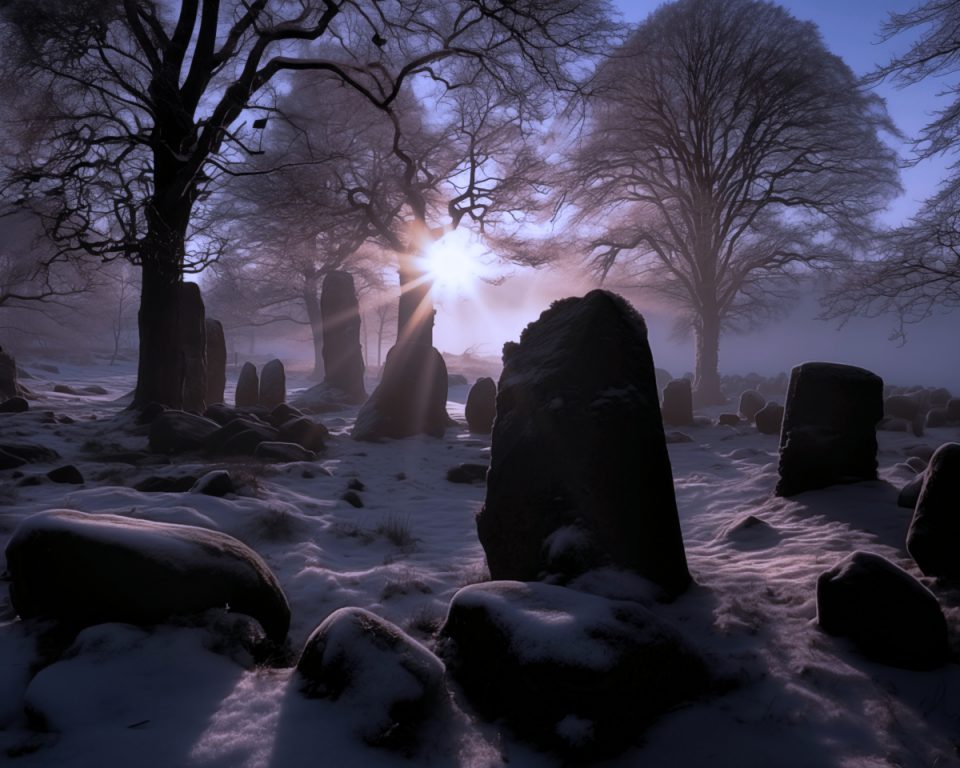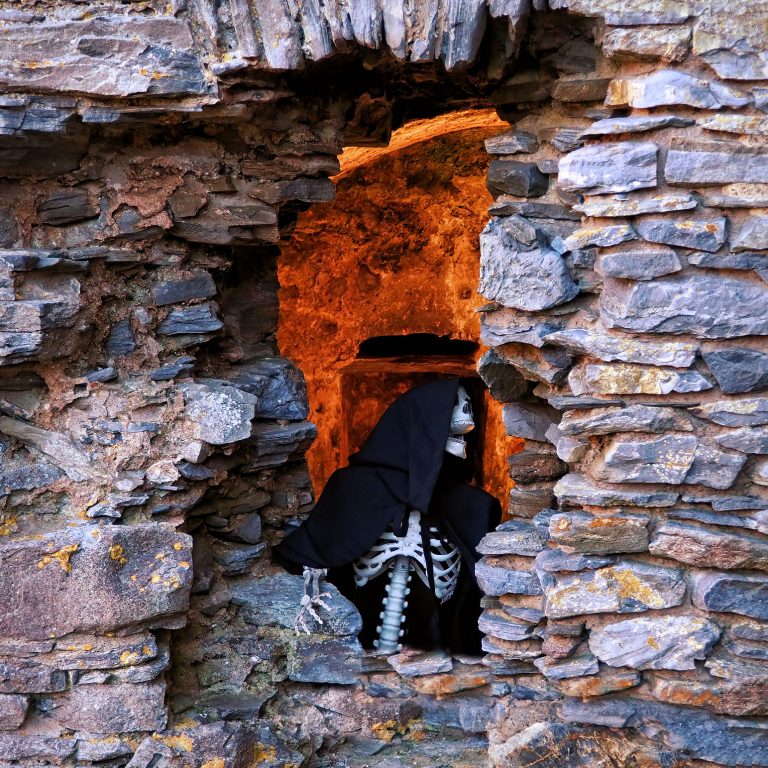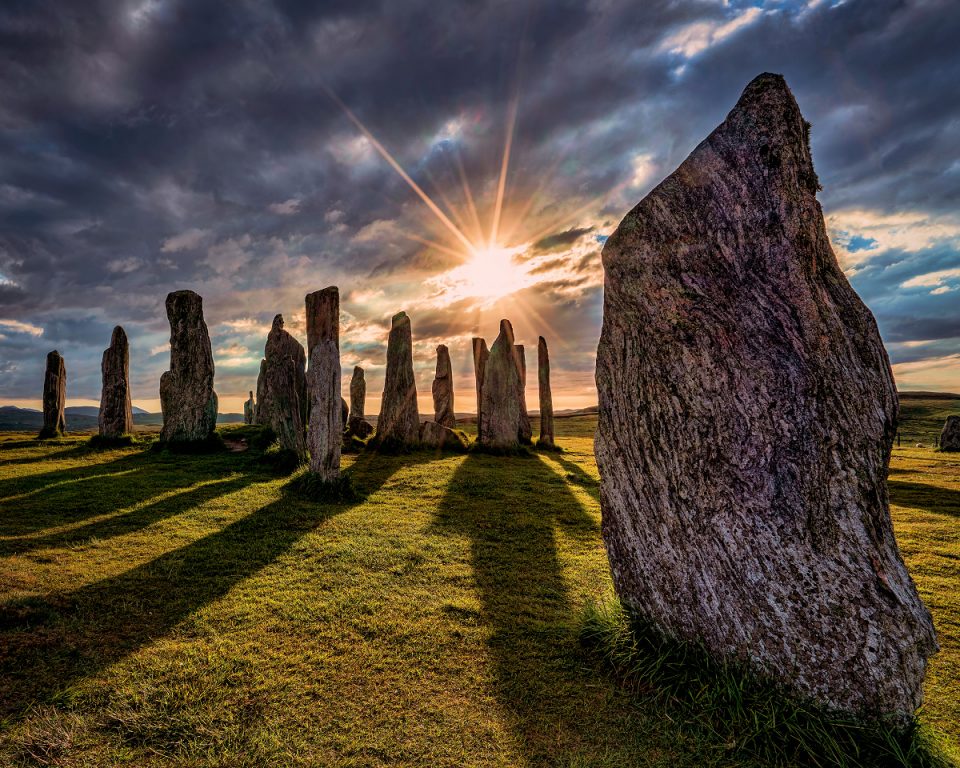The 18th of June is the Feast Day of the Nine Maidens in Scotland. But who were these women? Did they ever exist? Were they Christian reworkings of an ancient religion tied to Goddess worship? What is the connection between the Nine Maidens, the Cailleach and Brìde? What is their connection with Edinburgh and King Arthur? And why do others of other Nine Maidens appear in mythology and folk tales all around the world?
When the early Christian missionaries such as Columba arrived in Scotland, they were following a definite agenda. They would take Christian beliefs and merge them with pagan feasts and sites. Thus, All Saints Day was celebrated at Samhain and Candlemas was celebrated at Imbolc. Pagan Gods and Goddesses were canonised to become saints. The ancient Goddess Brìde became Saint Brigid. Churches were built upon the holy sites of the druids. Many of the very old Christian churches in Scotland have Pictish stones in the kirkyard. For instance, Birnie Church outside Elgin is one of the oldest churches still in use. It is built on the site of a Class I Pictish Stone bearing an eagle, over a divided rectangle and z-rod.
The Christian Version of the Nine Maidens
It is said that during the 6th Century that the Nine Maidens lived with their father, Saint Donald, in Glen Ogilvy, nestled in the Sidlaw Hills in Angus. Their home was turned into a hermitage where they lived a simple life of prayer and contemplation. They ate a single meal per day comprising of barley bread and water. Saint Donald was widely respected for his holiness and when he died, his daughters were loath to return to the world. They continued with their simple life and in time their reputation for holiness grew.
Eventually, it came to the attention of the Pictish King Garnard at Abernethy. The King invited them to come and live in Abernethy in Perthshire. There he built an oratory for the maidens and they lived out their days in solitude and prayer. When they died, they were buried at the foot of and huge oak tree. This story was told in a series of wooden panels upon in an oratory in the chapel at Abernethy. Alas, they were mindlessly vandalised during the Protestant Reformation. During the Reformation anything associated with superstition, saint worship and iconography was destroyed.
Nine Maidens and St Brigid
In another story, the Nine Maidens were said to have lived in the hollow of an oak tree before being granted a chapel, an oratory and land in Abernethy. They were said to be visited by Eugenius VII, King of the Scots. According to Forbes In the Aberdeen Breviary (1854) the Nine Maidens were said to have come from Ireland to Abernethy along with St Brigid. In Michael Barrett’s Calendar of Scottish Saints, he says
“They accordingly entered the monastery for women which St. Darlugdach, an Irish nun and the friend of St. Bridget (or as some say St. Bridget herself), had founded at Abernethy. Here they spent the remainder of their lives. There were many dedications in Scotland to these saints.”
The Names of the Sisters
The names of three of the sisters survive:
- Mazota (also known as St Maik or Moyota). Drumoak in Aberdeenshire was originally Dalmaik. There is an old well called St Maik’s Well. Her Saint day is celebrated on 22nd December
- Fyncana or Saint Fink
- Fyndoca
A number of churches have been named after them: the ancient church of Finhaven in Forfarshire, a chapel at Pitsligo in Aberdeenshire,and Tough in Aberdeenshire. Holy wells have also been called after them at Strathmartin, Glamis, Oathlaw (Forfarshire), Old Aberdeen, Pitsligo (Aberdeenshire), Newburgh (Fife) and Mid-Calder (near Edinburgh).
Pagan Undertones to the Saintly Nine Maidens
There are clues in the tale of the Saintly Nine Maidens lives that tell us that the story has its origins in Pagan beliefs. First, there are the timings of the feasts. The Feast of the Nine Maidens coincides with the Summer Solstice whereas Mazota’s feast date coincides with the Winter Solstice. These were important astronomical times in the lives of the early settlers in what later would become Scotland.
Then there is the connection with the oak tree which has clear pagan connotations and the connection with Saint Brigid, a major figure in the Celtic church derived from the ancient goddess Brìde. Many of the holy wells which are dedicated to saints date back to pre-Christian times. Interestingly, there was a custom at Welltrees Meadow in Sanquhar Parish in the Scottish Borders. In the past, a spring which flowed through the area was called St Bride’s Well. Apparently, the maidens of Sanquhar would gather at the well at Beltane, and each would bring an offering of nine stones in memory of the Nine Maidens.
The Nine Maidens and the Dragon
South of Glen Ogilvy at the other side of the Balluderon Hill, is a Pictish Stone known as Martin’s Stane. There is an oral tradition which explains the symbolism of the stone.
Long, long ago a man lived with his nine, reportedly beautiful daughters on farmland known as Pitempton. After a particularly arduous day tending the land, the farmer felt that his insatiable thirst could only be quenched by a pitcher of water fetched from a nearby spring. Having been so tired from his day of labouring, he entrusted his eldest daughter to the task. She eagerly obeyed her father, running to the well.
As time passed, and with no sign of his eldest daughter, the father sent the second-eldest daughter to find out what was delaying his daughter. Alas when she did not come back either, he sent his third daughter. That pattern repeated itself until he sent the last sister. Imagine her horror when she discovered the dead bodies of her sisters lying amongst the bulrushes.
Martin, The Rescuer
Coiled around their battered bodies, basking in the blood of the innocent victims, was a huge serpent-like dragon. Before she could escape, she found herself in the grasp of the beast. Screaming out with her dying breath, a crowd of neighbours gathered. Amongst them was the poor girl’s sweetheart, a man named Martin. Martin, a blacksmith, was a man of “brave heart and tremendous skill and courage”.
Perhaps sensing that it was no match for the baying mob, the dragon attempted to make its escape, fleeing north-west to Baldragon Moss, where it was ‘draggelt’ (soaked). Then the avengers drove the dragon north to Strathmartine and surrounded it. Martin urged on by cried of ‘Strike, Martin’, clubbed the mighty worm. The dying creature managed to crawl away to the spot where the stone now stands. It was again surrounded and finally slain by the young hero. Its dying words were:
I was tempit at Pittempton,
Draggelt at Badragon,
Stricken at Strike-Martin,
And killt at Martin’s Stone.
Incidentally, the place where the dragon was defeated was renamed “Strike-Martin” and was subsequently named Strathmartine. The church at Strathmartine is dedicated to St Martin.
Nine Maidens Slain by a Bear or a Boar
In Auchendoir in Aberdeenshire a tale is told about Ochonochar, an ancestor of the ancient landed family of Forbes. In this case a bear rather than a dragon is involved in the story. Ochonochar was a mighty Pictish warrior and he was called to the parish because a giant bear was terrorising the district. By the time he arrived, the bear had already killed Nine Maidens, including his sweetheart.
After a short but bloody skirmish, the fearsome creature was killed. Here the Nine Maidens Well is found at Logie on the River Don. Nearby at Kildrummy, there is a place called Nine Maidens’ Green where tradition says the Nine Maidens are buried. Tradition also says that the name Forbes came from Ochonochar’s heartfelt cry as he slew the beast, “For Bess!” It was said to be his love’s name. In some stories, it is a boar rather than a bear that it said to have killed the Nine Maidens, but three bears’ heads make up the Forbes coat of Arms.
Nine Maidens as Water Deities
According to the Writer and Folklorist J G MacKay, Bride and her Nine Maidens came from Glenesk. In Glenesk there is also lore suggesting that the Nine Maidens were once venerated as water deities. According to legend, this is where the best-loved piper in the Angus glens dwelt. One evening as he was playing his pipes near the Dalbrack Bridge, nine green-robed fairies sailed down the River North Esk in a boat. They leapt onto the bank and compelled the piper to go with them. Thrice, the boat sailed around the pool called Pontskinnen Pot, then vanished upstream forever, with the piper still playing. His tune is still sometimes heard distantly on summer evenings here.
A comparison with the Story of Brìde
Amongst the Gaels, the tale is told of the Goddess Brìde and her consort Angus. It closely parallels the Maidens’ story at Strathmartine. It is also strongly connected to the ritual Celtic calendar. St Martin’s Day, 11th November occurs close to Samhain the beginning of the Celtic year. On this day Brìde was imprisoned under Ben Nevis by the Cailleach, the hag who symbolised the power of winter overcoming summer. The hero Angus freed Brìde on St Brìde’s Day, 1st February, known as Imbolc. The Cailleach was finally slain on 25th March, named Lady Day or Auld Wives’ Day. Finally, summer was ushered in at Beltane.
Is it possible that the Christian St Martin replaces Angus, and the Dragon is the Cailleach, force of destruction and darkness? Pertinently, when Brìde emerged at Imbolc she was in the form of a Serpent Queen, not regaining her true form until the Cailleach died. The whole cycle is a rationalisation of the descent into winter and a celebration of spring’s rebirth.
The Nine Maidens and the Goddess
It is accepted that Saint Brigid was a Christian reworking of the Goddess Brìde and in Scottish terms, her relationship with the Cailleach is quite specific. From across Scotland, there are tales of the Cailleach or Carlin going to a sacred well before even a dog has barked on the morning of Beltane, drinking of the waters and transforming into Brìde. This is underpinned by the old agricultural calendar of Scotland being divided into the Time of the Big Sun and the Time of the Little Sun.
The Time of the Little Sun lasted from Samhain (Halloween) to Beltane (1st May) and was the time of the Cailleach, the Hag of Winter, a fearsome creature symbolic of death and destruction. Meanwhile, the Time of the Big Sun was the time of Golden Brìde, effectively the Goddess of fertility. They are thought to be one and the same, different manifestations of the Goddess, the Creator and Mother of All.
An Emerging Pattern
The Nine Maidens are linked to both aspects of the Mother Goddess and there are wells in various parts of the country named for them. Many of these have been overlaid with Christian sites.
A pattern is forming of a cluster of Nine Maidens associated with Saint Brigid in various locations around Scotland and also in Ireland too. This seems to be indicative of groups of Nine Maidens being associated with Goddess worship throughout Scotland. According to Stuart McHardy these women may have gathered on ancient holy hilltops. The Cailleach, the Goddess in her ‘Hag’ form, is often associated with Mountains such as Ben Nevis, Ben Cruachan and Ben Wyvis. At Lochnagar, we find a couple of Cailleach place names: Caisteal na Cailich and Allt na Cailleach.
The Nine Maidens and Saint Monenna
Other evidence that there were groups of Nine Maidens at several tribal capitals of Dark Age Scotland is found anciently at Edinburgh. Saint Monenna was said to be a friend of Saint Brigit. She arrived from Ireland with eight virgins and a widow. The widow brought with her a son Luger, whom Monenna adopted as her foster son and who later became a bishop.
She is known by several names such as Darerca, Modwenna, Moninne and is possibly also Edana and Medana. It was said that her edifice was at Edinburgh Castle on the site where Saint Margaret’s Chapel is now. According to the English 16th century historian, Camden The Britons (the ancient Welsh-speaking peoples of Scotland) called it Mynydh Agnedh, the Maiden’s or Virgin’s Castle.
Nine Maidens at Edinburgh Castle
Archaeological evidence has shown that there were Iron Age settlers at the site, from the 2nd Century. Originally the castle was called Maiden Castle or Castella Puellarum in Latin. It was only in the 12th Century that the site began to be used as a fortified castle, in the reign of David I. He built Saint Margaret’s Chapel, the oldest standing building within the Castle Compound. He built this in memory of his mother who became the foremost of the Scottish female saints.
Apparently, when he went to build the Chapel, certain ‘nuns’ were thrust out of the pre-existing shrine. They may not have been nuns but Pagan priestess or perhaps the pagan priestesses had long been replaced by nuns as the church spread across Scotland, supplanting pagan beliefs with a form of Christianity mingled with pagan lore. Interestingly the word Cailleach means ‘veiled one’ in Gaelic. It later became the Gaelic word for a nun.
Interestingly, excavations under the Chapel in 1853, recovered a number of human bones. All of them were female.
Legend has it that the ‘Castle of the Maidens’ at Edinburgh was a shrine to the Nine Maidens, one of whom was Morgan Le Fay of Arthurian legend.
Nine Maidens and Arthurian Legend
Of all the Celtic myths, perhaps the tale of King Arthur is the most famous. The Nine Maidens turn up here as well as the Nine Sisters of Avalon. It should be remembered that in 6th Century Scotland the languages spoken would have been Pictish, Gaelic and Ancient Welsh. Welsh would have been spoken by the tribes in Southern Scotland. Welsh and the ancient Celtic languages of Cornwall and Brittany are linguistically related and are referred to as P-Celtic languages. It is likely that Pictish belongs to this class of languages too.
The stories of Arthur were common to all the P-Celtic speaking peoples. Legends of Arthur abound in Scotland. Indeed, the first recorded mention of Arthur comes from an ancient Welsh poem called ‘Y Gododdin’. This poem survives in one manuscript: The Book of Aneirin. This book dates to the 13th Century but the poem is thought to be of much earlier origin predating 638 A.D. when the fall of Din Eidyn occurred at the hands of Oswy, King of Bernicia. It is a series of elegies for heroes who died in battle. This poem was written in Scotland by a bard of the tribe known as the Gododdin. The arrival of the Anglo-Saxons pushed the Welsh-speaking Britons westward until they were pushed to the fringes of the west, to Wales and Cornwall.
Edinburgh and Arthurian Legend
The fall of Edinburgh severed the Welsh-speaking peoples in two and eventually, the Northern Britons were incorporated into the future Kingdom of Scotland. Here they retained a memory of a mighty hero named Arthur. For the Gododdin the Isle of Avalon would probably have been the Isle of May in the Firth of Forth, its name, in Scots, meaning exactly The Isle of the Maidens. Archaeologists have shown that this was a place of pilgrimage from pre-Christian into Christian times. There are those who think that Arthur’s Seat in Edinburgh may have been the site of Camelot.
The Nine Maidens across the World
But the Nine Maidens motif is not solely associated with Scotland or even the other Celtic speaking peoples. It is entrenched in Germanic tradition. In Norse lore, they are the daughters of the Sea-God Aegir who become the nine mothers of Heimdall. They are also found in the story of Svipdag who meets Menglod, Goddess of Healing who has nine companions. Also, in Norse mythology, there is the Nine Maidens of the Mill. These nine giant women were said to have created the earth by turning the Mill in which the body of the Ice Giant Ymir was ground. The Valkyries of Norse and Germanic tradition are often nine in number.
The 2nd-century Greek geographer Strabo refers to the nine Druidesses of the Isle du Sein off Brittany who were called the Gallicenae. They were known as healers, shapeshifters and seers, a recurring idea which corresponds with the Nine Sisters of Avalon and others. The more recent name for the island is Isle des Druidesses, suggesting that at least locally they were understood to be some kind of priestesses. Then there are the nine muses of Greek mythology.
The Fifteen-Thousand Year Old Maidens
However, the oldest European reference to them is found on a fifteen-thousand-year-old cave painting in Portugal. The Magdalenian cave painting at El Cogul, near Lerida, shows nine women dancing round a male with a huge phallus. Most commentators have remarked on the ritual appearance of this scene and it does seem to point to the possibility that many of the nine groups as being some kind of priestesses.
The Nine Maidens turn up in other cultures including the Americas and the South Seas and amongst shamanistic beliefs in Siberia, but the most remarkable of them all is probably a traditional story from Kenya. There the Gikuyu people of Kenya claim descent from a group of nine sisters who, like so many of their counterparts, are linked to a sacred mountain, in this case, Kilimanjaro, Africa’s highest peak.
The Nine Maidens: A Scottish perspective
The Nine Maidens at the centre of the Scottish Feast it seems are a reworking of a pagan belief in a Goddess Creator. It seems that in ancient Scotland groups of Nine Maidens, Pagan Priestesses met at sacred sites, often on hilltops to worship a dual Creator Goddess, that symbolised the turning of the wheel of the year. These priestesses were involved in augury and healing.
But it seems that this is part of an ancient worldwide belief system which is passed down to us today in folklore and tradition. Who knows, perhaps the builders of Maeshowe and the Calanais Standing Stones erected their monuments in memory of this Goddess.
Please feel free to share the spooky by using the links below or leave us a message in the comments box.




